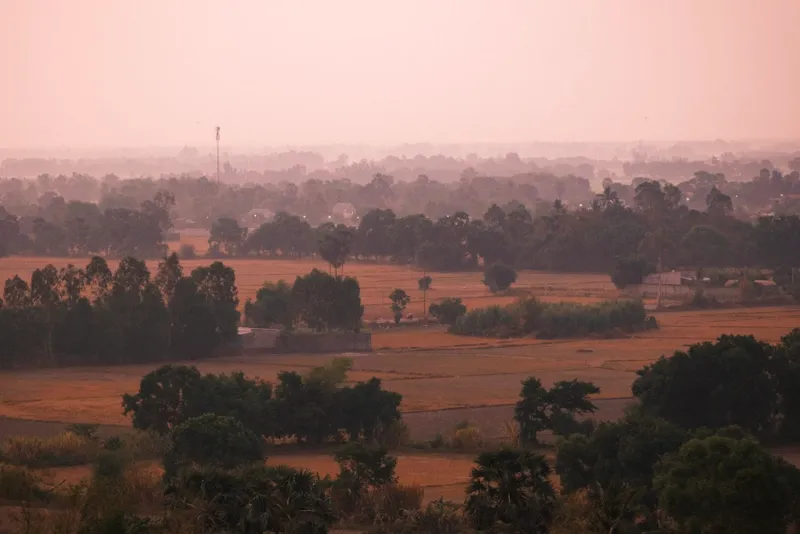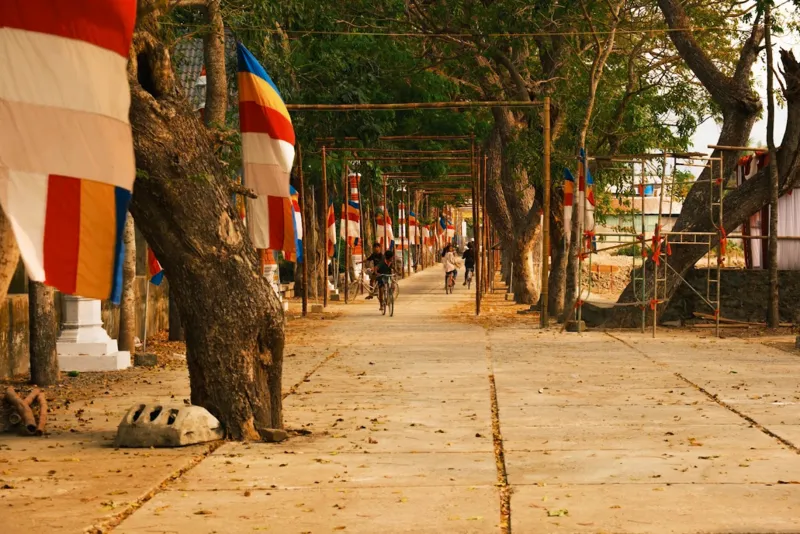
Upon arriving in An Giang, we felt as if the land had cast a spell on us. The more we admired the scenery, the more captivated we became by the grandeur and mystique of Khmer Buddhist temples.
These temples not only embody religious beauty but also reflect the artistry and soul of the Khmer community. Let us take you on a journey to explore three outstanding Khmer Buddhist architectural masterpieces in the Seven Mountains region of An Giang.
Koh Kas Gate – A Portal to the Mystical Realm
Koh Kas Gate, also known as Tri Ton Gate, serves as the entrance to Koh Kas Pagoda (Tual Prasat Pagoda), a unique destination in Tri Ton, An Giang. Although it is merely a part of an ancient Khmer temple, this structure has an irresistible allure due to its distinctive beauty and location.

Situated along Provincial Road 949, Koh Kas Gate stands as the gateway to a winding path surrounded by vast fields and towering mountains of Tri Ton. It sits some distance away from the temple's main complex, appearing as a lone, majestic portal amidst the expansive landscape.
In the late afternoon, smoke from cooking fires and burning straw drifts through the air, blending with the soft light of dusk to enhance the gate's already mysterious aura.
Adorned in vibrant hues of gold and red, the gate showcases the hallmark of Khmer architecture, with intricately carved and embossed details of significant motifs like the *Naga serpent, **Garuda bird, and ***Kâyno goddess.
* Naga Serpent: A revered figure in Hindu traditions, later integrated into Buddhist art across Asia.
** Garuda Bird: A mythical creature from ancient Indian mythology, often depicted as the mount of Vishnu, one of the supreme deities of Hinduism.
*** Kâyno Goddess (Apsara): Ethereal beings known for their grace, beauty, and skillful dances, often associated with heavenly music and divine celebrations.
During our first visit, we were awestruck by the sculpted Naga serpent, coiled in a poised yet commanding stance, seemingly warning visitors to approach with pure intentions.

Koh Kas Gate is a blend of Khmer cultural heritage and artistic harmony with nature. When sunlight filters through, the intricate carvings glow, instilling a sense of reverence in all who visit.
Ta Pa Pagoda – A “Floating” Temple Amidst Nature
Perched atop Ta Pa Mountain, Ta Pa Pagoda, also known as Chhnang Pagoda, is one of An Giang's most unique Khmer temples. Its distinctiveness lies not in its architectural design but in its extraordinary location.

Ta Pa Pagoda leaves any visitor amazed by its grandeur and magnificence. Covering an area of nearly 4,000 square meters and situated over 45 meters above sea level, the pagoda is surrounded by the lush forests and mountains of Tri Ton. Its sanctuaries are supported by tall, sturdy concrete columns.
The pagoda’s roof features pointed, tower-like structures, standing out with vibrant hues of orange and blue, making it resemble woven brocade fabrics when viewed from a distance. In addition to its striking roof, the walls, columns, and bas-reliefs are equally captivating, adorned with rich shades of red and gold—colors commonly found in Khmer Buddhist temples.
We arrived at the temple in the late afternoon, as the weather began to cool. Climbing the stairs, we felt the tranquil aura of Tri Ton envelope us. As we approached the summit, the temple’s grandeur became even more striking.


Ta Pa Pagoda serves not only as a place of worship but also as a sanctuary for those seeking peace and serenity. From its grounds, visitors can enjoy panoramic views of rice fields, roads, and forests stretching below.
Krang Kroch Pagoda – A Tranquil Retreat Beneath Ancient Trees
Located in Tri Ton, Krang Kroch Pagoda, or the "Pagoda of the Rain Trees," is not only a symbol of Khmer cultural heritage but also a serene haven shaded by towering rain trees.

The rain trees lining the path were planted in 1965 and have since become an iconic feature of this pagoda. Thanks to their shade, the pagoda enjoys a natural canopy that casts cool shadows along the entire pathway, guiding visitors as they come to worship or explore. This serene and sacred site, known as Hang Cong Pagoda, feels even more tranquil and welcoming beneath the gentle cover of these ancient trees.
Rich in Khmer Buddhist characteristics, Hang Cong Pagoda features a steeply arched roof adorned with intricate carvings of cultural symbols unique to Khmer heritage. Although not as expansive as other Khmer temples, it remains a significant draw for locals and visitors alike. The pagoda hosts important Khmer community rituals and festivals, such as the Dolta Festival (Ancestor Worship) and Chol Chnam Thmay (Khmer New Year).
For the local community, this pagoda is more than just a place of spiritual devotion—it serves as a cultural anchor, bridging generations.
When we visited, the pagoda was undergoing restoration, and we had the chance to witness the monks repainting its structures. Despite the intense Tri Ton heat, the monks' saffron robes blended with the bright paint under the sun, creating a dazzling scene that left us mesmerized.


The journey to explore the three Khmer pagodas in An Giang brought us profound insights and unique emotions. The deeper we delved into these culturally significant structures, the more we realized that these pagodas are not only important religious sites but also exquisite works of art. Despite all being Khmer Buddhist temples, each one tells its own story and showcases its beauty, enriching the cultural and spiritual tapestry of the Khmer community in Southern Vietnam.
If you ever have the chance to visit An Giang, be sure to set aside time to explore these remarkable landmarks. They offer a wonderful opportunity to witness the harmonious blend of humanity, culture, and nature in this peaceful region.






